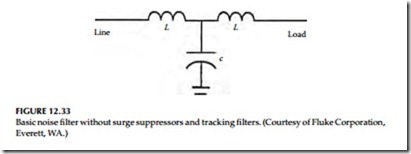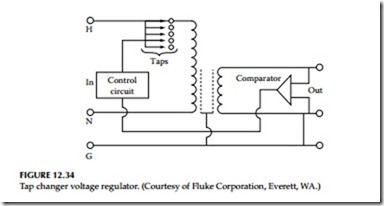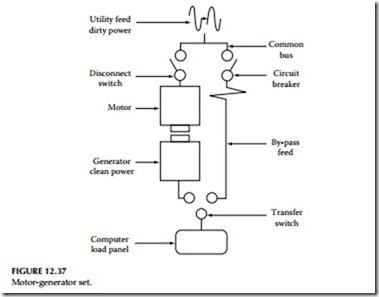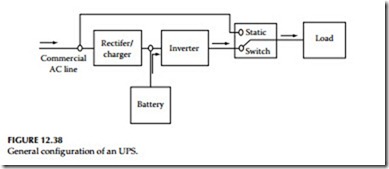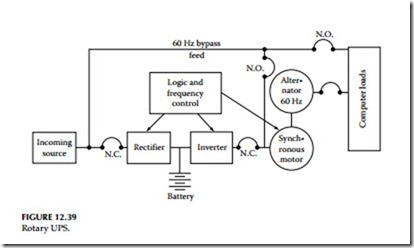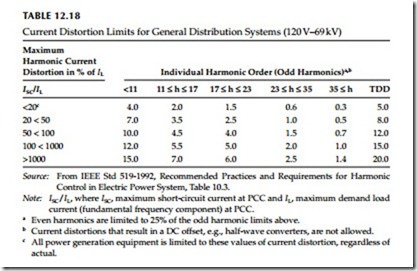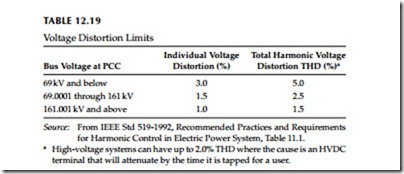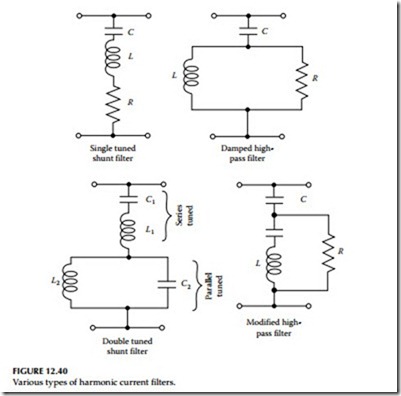PQ Solution and Power Treatment Devices
In Sections 12.1 through 12.5, we discussed concepts, origins, characteristics and effects of voltage disturbances, and HDs on power system equipment. In Section 12.6 a predictive maintenance and troubleshooting guide was presented to identify and quantify the PQ-related problems. Once the PQ problem is identified and its effects on power equipment are understood, the next obvious step is to find a solution to correct the offending problem? There is no one answer that fits all PQ-related solutions. Each type of PQ problem
requires its very own solution or treatment. There are many power treatment devices that reflect different philosophies advocated by varying PQ professionals. To the user the wide variety of what is available on the market for resolving PQ problems can be confusing and frustrating. However, there are some basic considerations in selecting and applying PQ solutions that all agree upon. First, is there a single problem or multiple problems, and is the nature of the problem(s) understood so an informed solution can be implemented; second any solution or treatment device installed has to obey the laws of physics and must be implemented without adversely affecting the loads; third the installation of the treatment device must be done correctly because if improperly installed, it may be detrimental to the system operation as was the original problem; and last the treatment device must be compatible with the load otherwise it may interact with the load causing a condition that is actually worse than before. The solutions and power treat- ment devices for solving PQ problems can be classified into three problem categories:
1. Voltage disturbances and noise
2. HDs
3. Wiring and grounding
Treatment devices are applied to modify a given electrical power to improve its quality and reliability for correct functioning of its loads. They can perform a range of functions such as voltage regulation, noise elimination, and standby power supply (SPS), among others. Many different types of mitigating devices are available, but specification and selection of mitigat- ing equipment is dependent upon two considerations. First, the type of load to be powered must be considered. Single loads are effectively regulated with the proper mitigating device. However, larger systems that support many loads are far more complex. Requirements of all loads require consideration, as well as the potential interaction between them to determine the proper mitigating devices required. Second, the equipment requirements for each application must be considered. Examples of such requirements include PQ requirements of the load, problems (improper wiring and grounding, temperature, humidity, ESD, etc.) which could interfere with proper operation of the critical load, type of conditioning required, future quality and reliability of the power supply, and cost to eliminate or mitigate power-related problems. The most commonly used mitigating devices and their characteristics for the three categories identified above are discussed as follows:
Voltage Disturbances and Noise
The voltage disturbance, such as impulses, transients, swells, voltage dips, and interruptions were discussed in Section 12.2. The treatment devices for mitigating voltage disturbances and noise may be grouped as follows:
• Line (noise) filters
• TVSS
• Voltage regulators
• Isolation transformers
• Power conditioners
• UPS
Noise Filters (Electronic Filters)
Noise filters prevent interference (e.g., conducted EMI and/or RFI) from traveling into sensitive electronic equipment from the power source. These filters also prevent equipment that generates interference from feeding it back into the power line. Most sensitive electronic equipment utilize some type of noise filter. A basic noise filter is low pass LC filter, that is it passes line fre- quency (60 Hz) and blocks the very high frequencies or steep wave front transients (Figure 12.33). This is accomplished by series inductors followed by capacitors to ground. The inductor forms two impedance paths: one low for the 60 Hz power and one high for the high-frequency noise. The remaining high-frequency noise is conducted by the capacitor to ground before it reaches the load. Many line filters are based on surge suppression components, such as surge suppressors but also have components that pro- vide frequency response and waveform tracking. Waveform tracking allows the filter to clamp impulses at lower voltages than TVSS. The line filters exert more control over normal mode events compared to CM event because of absence of ground isolation capabilities. The line filters are listed under UL 1012, Standard for Safety of Power Supplies.
TVSS
TVSS protect against voltage spikes and oscillatory-transient voltages. They are either gap type or the clamping type. The gap type is relatively slow acting (microseconds) with large energy handling ability. The clamping type is fast acting (nanoseconds) with somewhat smaller energy-handling ability. The gap type units are best used near the power source entrance where as clamping type units are used near the equipment being protected.
The four basic types of equipment used for protection from transients are crowbar devices, voltage-clamping devices, attenuation (filtering) devices, and hybrid devices. The crowbar devices include air gaps, gas discharge tubes, lightning arrestors, and switching devices. The voltage-clamping devices consist of varistors (nonlinear resistors), MOVs, zener diodes, and selenium rectifiers. These devices are unidirectional conductors until a breakdown voltage is reached, at which time they conduct in the reverse direction. Attenuation devices are inserted in a circuit to permit power at line frequency to pass, while attenuating transients. They are referred to as noise filters or low-pass filters. The attenuating devices are not truly suppression devices, but have applications when noise or transients at particular frequencies are found on a specific power or data line. Hybrid devices are transient suppressors that combine two or more technologies to provide transient suppression over a wide range of voltages, rates of rise, and energy content. Protecting computers and sensitive electronic equipment against transients is a good installation practice. Careful grounding is necessary for these devices to be effective. Power to computers also should be separated electrically as much as possible from the remainder of building power system. Incoming power lines, data and communications lines entering from outside the building, and those inside the building subjected to transients should have transient protection. Separate protection for individual units may be needed (unless already built into the equipment) for computers and sensitive electronic equipment. In selecting the transient suppression devices, careful consideration should be given to the voltage rating of the devices. The devices selected should have a minimum voltage rating that is higher than the system or data line voltage or phase-to-phase or phase-to-ground voltage. Selecting the energy dissipation rating required is somewhat more difficult since it is rarely possible to predict the energy content of the transient that might occur. The device selected must survive the worst possible transient and, at the same time, the clamping voltage must not exceed the withstand voltage rating of the equipment being protected. Transient devices should be installed using the shortest possible conductors, so that its inductive reactance is small at high transient frequencies. UL standard for safety, 1449 provides criteria for safety and performance testing of TVSS. TVSS tested and approved in accordance with this standard list the approval marking and maximum suppression voltage of the device.
Voltage Regulators
There are two types of voltage regulators that are available for maintaining correct voltage to the load. They are line voltage regulator and constant volt- age regulator. The line voltage regulators maintain a relatively constant voltage output within a specified range, regardless of input voltage variations.
Although DC line voltage regulators are built into most sensitive electronic equipment, AC regulators are only now being built into some equipment. These regulators use the same ground reference on output as for the incoming power. They can only modify input line voltage amplitude and cannot establish a new signal. Solid-state devices (e.g., constant voltage and tap-changing transformers) are being used almost exclusively, rather than electromechanical types.
Line voltage regulators typically are used to protect against momentary and transient disturbances within a certain range. These regulators have a typical response time of 1 cycle. While many voltage problems can be handled by the appropriate application of a line voltage regulator, it is not suitable to protect sensitive electronic loads against rapid changes in volt- age. They also do not have noise suppression capabilities. Regulators with switching power supplies actually create noise, and therefore are unsuitable for critical loads. The regulators also can become unstable if other regulators with similar response times are on the same circuit. Two types of line voltage regulators currently are available: tap changers and buck–boost.
The tap changers, also known as tap switchers or electronic tap switch- ing transformers, regulate output voltage in response to fluctuations in input voltage or load (see Figure 12.34). This is accomplished with solid- state switches (SCRs or triacs) which automatically select appropriate taps on a power transformer (either isolating type or autotransformer type) at the zero current point of the output wave. Some of these devices are volt- age switching type units that make the tap change at the voltage zero crossing. This causes a transient to be generated except when the load is at unity PF. The magnitude of this transient is determined by actual load conditions.
The buck–boost regulators assure smooth continuous output by regulating heavy inrush currents typically delivered by computer start-ups or disk drive motors. When power is fed into these regulators, they either add to (boosts)
or subtract from (bucks) the incoming voltage. These electronic devices eliminate use of steps as compared to the tap changer. Output is maintained constant for 15%–20% variations of input voltage. This is accomplished by comparing output voltage to the desired (set) level and by the use of feedback to modify the level of boost or buck. A path for nonlinear currents generated by the load and by the regulator itself is provided by a parametric filter. An advantage of buck–boost regulators is that they attenuate normal mode noise and surges. In addition, if they are built with isolation and shielding, the regulators can be separately derived source for power grounding, and can provide CM noise reduction.
The constant voltage regulator is typically referred to as ferroresonant regulators or constant voltage transformers (CVTs). This type of regulator is a relatively simple device because it has no moving or active electronic parts. It uses a saturating transformer with a resonant circuit made up of the trans- former’s inductance and a capacitor (Figure 12.35). The unit maintains a nearly constant voltage on the output for input swings of 20%–40%.
CVTs are susceptible to load imbalances and can become unstable. If the load current gets too high, these transformers tend to go out of resonance. They often can only supply 125%–200% of their full load rating. As a result, the CVTs cannot support starting current of motors exceeding these limits without a drastic dip in output voltage. CVTs are very inefficient at light loads and less efficient at all other load levels. Their poor efficiency is due to the resonant circuit which handles relatively large amounts of current all the time. As a result, the circuit causes the heat loss to be higher than other types of regulators. Noise can be a problem with these transformers requiring spe- cial enclosures. Because of its saturating elements, the CVT is a nonlinear device and introduces harmonic currents on the power source supplying it. The constant voltage regulators should be oversized in order to provide for heavy starting or in-rush currents. This is because output voltage is sig- nificantly reduced when these regulators are near their current limits.
The possibility also exists that the output voltage may not be compatible with some loads. In some cases, this can shut down other devices as a result of low output voltage of the CVT.
Isolation Transformers
Isolation transformers incorporate separate primary (or input) and secondary (or output) windings with electrostatic Faraday shielding around the windings. They perform two distinct functions. First, they transform or change the input to secondary output voltage level and/or to compensate for high or low voltage. Second, the transformers establish the power ground reference close to the point of use. Because of this, CM noise induced through ground loops or multiple current paths in the ground circuit upstream of the established reference ground point is significantly reduced.
Isolation transformers introduce minimal magnetizing current distortion into the input source. The delta-connected primary winding of the transformer can reduce the balanced third harmonic currents fed back to the source by single-phase nonlinear loads which are supplied from three- phase feeder systems. When a delta primary, wye secondary, isolation transformer is used to power a load such as a single-phase rectifier, the balanced third harmonic currents circulate in the delta primary so they are not seen by the power source. An isolation transformer may be designed with a simple electrostatic (Faraday) shield between the two sets of wind- ings or they can be equipped with multi shields. Figure 12.36 shows an isolation transformer with three electrostatic Faraday shields, where pri- mary and secondary winding are individually shield with an overall shield system. A single shield is normally adequate in most applications however additional shields increase the CM rejection capabilities of the transformer. This Faraday electrostatic shield comprises of conducting sheets of nonmagnetic material (copper or aluminum) connected to ground. They are designed to improve the isolation characteristics of the transformer. Electrostatic shielding adds little to the cost, size, and weight of the transformer. Isolation transformers can achieve efficiencies from 95% to 98%. These transformers generate little heat and are relatively quiet. They can be installed separately or with PDUs. Isolation transformers with distribution units have the advantage of being able to be located very close to the critical load.
Power Conditioners
Power line conditioners consist of one or more basic power treatment devices as previously discussed in this section. Some power conditioners may provide impulse attenuation, high-frequency filtering, isolation and voltage regulation others may not provide these features. Some of the power conditioners are: enhanced isolation transformer, ferroresonant power
conditioner, tap switching power conditioner, magnetic synthesizer, and motor generator (M-G) sets. These conditioners also provide a locally derived source with isolation while providing voltage regulation. Some advanced conditioners contain noise reduction features of isolation trans- formers, filtering devices with voltage regulators, or surge suppressors to clamp high voltage surges.
The enhanced isolation transformer uses MOVs and air core wound chokes on the primary and a large capacitor across the secondary. These transform- ers were designed primarily for modern SMPS. The impedance of the transformer is kept low to ensure capability with the high inrush current of the power supply. The enhanced isolation transformers are available with single or multiple shields for improved CM noise attenuation.
The ferroresonant power conditioner is an isolation transformer operating in a saturated mode which was discussed in Section 12.7.1.3. It operates like a ferroresonant regulator with capability to regulate voltage and to a degree perform waveshaping. Also, shielding between the primary and secondary improves the high frequency attenuations capabilities.
The tap switching power conditioner is an isolation transformer with multiple taps for voltage correction. However, some tap switching power conditioners do not use isolation transformers, but instead use autotransformer. This power conditioner has the capability to regulate voltage, provide impulse attenuation and filtering.
The magnetic synthesizers consist of nonlinear inductors and capacitors in a parallel resonant circuit with six saturating pulse transformers. These synthesizers draw power from the source and generate their output voltage waveform by combining the pulses of the saturating transformers in a step wave manner. They provide noise and surge rejection and regulation of output voltage to within 10% over large swings (50%) input voltage. These units generally include additional filtering to eliminate self-induced harmonics and pulse transformer shielding to attenuate CM disturbances. The magnetic synthesizer inherently limits maximum current at full voltage to 125%–200% of the rating. With greater loads, voltage drops off rapidly, producing typically 200%–300% current at short circuit. Large step load changes, even within the unit’s rating, can cause significant voltage and frequency transients in the output of this conditioner. These regulators work best when the load does not make large step changes. Due to the magnetics involved, these synthesizers tend to be large and heavy. They also can be acoustically noisy without special packaging. Some of the larger units display good efficiencies, as long as they are operated at close to full load. The magnetic synthesizer introduces current distortion on its input, due to its nonlinear elements, which is at its highest when the conditioner is lightly loaded.
The M-Gs transform AC electrical power to mechanical power, then back to AC electrical power. They consist of an AC powered electric motor driv- ing an AC generator, which then supplies AC power to the load as shown in Figure 12.37. Two types of M-Gs are utilized today. These are shaft or belt isolated M-Gs and rotating transformer M-Gs. In the former, the motor and generator are coupled by a shaft or belts. The latter units have a common rotor, a motor stator, and a generator stator. They generally are small units and have excellent efficiency values. One disadvantage is that they do not provide the same level of noise and surge isolation between the input and the output as conventional M-Gs. Because of the coupling between the two stators (which are wound one on top of the other), the noise has a path through the unit. Shaft or belt isolated M-Gs are used widely as a source of 415 Hz power for large computers requiring this frequency. They can be easily powered by a single 60 Hz induction motor. As the induction motor speed varies, the output frequency varies with motor speed since the gen- erator output is a function of its shaft speed. However, the output voltage is maintained by controlling the excitation of the field winding of the generator and the generator output voltage is independent of small motor speed changes.
UPS
An UPS conditions incoming power and provides continuous power in the event of a power failure (Figure 12.38). UPS typically contain batteries that can be used during power interruptions. They are either online or off-line and are available in a wide range of configurations, from battery backup to units backed by a standby generator that can supply power for days. Two types of UPS systems predominately used are static and rotary UPS (RUPS).
Static UPS systems: A majority of UPS systems used today are static. They are preferred over rotary systems because of lower cost, higher efficiency,
ease of maintenance, and fewer moving parts. Static UPS systems instantly provide power from battery to the load in the event of a power failure. Batteries used for large installations usually are lead-acid wet cells. Some smaller units use gelled-electrolyte cell or immobilized-electrolyte cell (maintenance free) batteries. Cost is influenced considerably by the length of battery protection time required and load size. In most instances, 15 min of protective time is considered adequate because it permits an orderly shut- down of the load equipment. In many instances, however, the UPS system is used in conjunction with an engine-generator set. As such, the UPS provides instantaneous power until such time as load can be transferred to the engine- generator set. In the event of an inverter failure or while maintenance is being performed on the UPS, a bypass transfer switch is included to allow connection of the utility to the critical load. This load can be transferred without interruption because UPS output is kept in phase with the utility source under normal operation. Static UPS systems can be either float-type (online) or AC-input type.
The RUPS systems can be configured in several different ways. In one configuration, shown in Figure 12.39, the rectifier of a RUPS is supplied from the utility source while the battery floats online. The inverter’s output frequency is slaved to the utility source and follows it exactly. The solid- state rectifier supplies DC to the inverter and also maintains the battery at appropriate float charge. The step function square wave AC output is used to drive the motor which, in turn, powers the generator. The M-G’s output frequency is maintained at 60 Hz. When the incoming power is interrupted, the high-capacity batteries supply DC to the inverter which, in turn, sup- plies power to the M-G set. The inverter frequency control system maintains motor frequency within ±0.1% of rated 60 Hz while the batteries supply the load.
Also, the UPS can be configured as SPS systems to provide energy that can be used during power interruptions. SPSs typically comprise of batteries and are either off-line or stand-by type. Two categories of SPSs that are used to supply backup power are rotary and static SPS systems. These systems are designed as standby systems such that during normal operation the power is supplied via the bypass circuit to the loads. If a power interruption occurs, the SPS switches to the battery to supply power to the inverter, which in turn supplies the load.
12.7.2 HDs
The effects of HD on power equipment and circuits were discussed in Section 12.5. High levels of stress due to HD can lead to problems for the utility’s distribution system, plant distribution system and any power equipment serviced by that distribution system. Effects can range from spurious operation of equipment to a shutdown, such as machines or assembly lines, or catastrophic failure of equipment. Harmonics can lead to power system inefficiency as well because increase in HD will decrease true PF. Some of the negative ways that harmonics affect plant equipment are summarized below:
Conductor overheating: Conductor heating is a function of the square of the rms current per unit volume in the conductor. Harmonic currents on under- sized conductors or cables can cause a skin effect, which increases with frequency.
Capacitors: Capacitors are affected by heat increases due to power loss (temperature rise) which will shorten life of capacitors. If a capacitor is tuned to one of the characteristic harmonics such as the fifth or seventh, overvoltages due to resonance can cause dielectric failure or rupture of capacitor.
Fuses and circuit breakers: Harmonics can cause false or spurious operations of relays, breakers and protective trips, damaging or blowing components.
Transformers: Transformers have increased iron and copper losses or eddy cur- rents due to stray flux losses. This causes overheating of transformer windings and iron (core).
Generators: Generators experience similar problems as transformers. Sizing and coordination is critical to the operation of the voltage regulator and controls. Excessive harmonic voltage distortion will cause multiple zero crossings of the current waveform. Multiple zero crossings affect the timing of the voltage regulator, causing interference and operation instability.
Revenue meters: Revenue meters may record measurements incorrectly, resulting in higher billings to user.
Drives/power supplies: VFDs and power supplies can be affected by misoperation due to multiple zero crossings. Harmonics can cause failure of the commutation circuits, found in DC drives and AC drives with SCRs.
Computers/telephones: These devices may experience interference or failure.
Industry Standards on Limits of Harmonics
The most often quoted standard on harmonics in the United States is IEEE 519-1992, “Recommended practices and requirements for harmonic control in electric power systems.” The IEEE 519-1992 attempts to establish reason- able harmonic goals for electrical systems that contain nonlinear (harmonic producing) loads. The objective is to propose steady state harmonic limits that are considered reasonable by both electric utilities and their customers. The underlying philosophy is that
• Customers should limit harmonic currents
• Electric utilities should limit harmonic voltages
• Both parties share the responsibility for holding harmonic levels in check
IEEE 519 applies to all voltage levels, including 120 V single-phase residential service, industrial and commercial entities, and utilities as well. While it does not specifically state the highest-order harmonic to limit, the generally accepted range of application is through the 50th harmonic for the industrial and commercial facilities. DC, which is not a harmonic, is also addressed and is prohibited. Since no differentiation is made between single-phase and three-phase systems, the recommended limits apply to both. It is important to remember that IEEE 519-1992 is a recommended practice and not an actual standard or legal document unless it is adopted by the local jurisdiction. Rather, it is intended to provide a reasonable framework within which engineers can address and control harmonic problems. It has been adopted by many electric utilities and by several state public utility commissions, such as Texas and Oklahoma states.
According to the IEEE 519-1992 standard, the industrial and commercial entity is responsible for controlling the harmonic currents created in their power systems. Since harmonic currents reflected through distribution system impedances generate harmonic voltages on the utility distribution systems, the standard proposes guidelines based on industrial distribution system design. The Table 10.3 in IEEE 519-1992, defines levels of harmonic currents that industrial and commercial customers can inject onto the utility distribution system. The contents of this table are shown in Table 12.18.
Table 11.1 of IEEE 519-1992 defines the voltage distortion limits that can be reflected back onto the utility distribution system. Usually if the industrial or commercial user controls the overall combined current distortion according to Table 10.3 of IEEE 519, this should help the customers meet the limitations set forth in the guidelines of IEEE 519 standard (Table 12.19).
Evaluating System Harmonics
In order to prevent or correct harmonic problems within an industrial or commercial facility an evaluation of system harmonics should be performed to quantify the problem. The harmonic evaluation can be conducted by either
performing an on-site measurement at the PCC, or by modeling the power system and performing a harmonic analysis study using a computer simulation. The evaluation should determine total harmonic voltage and current distortion (THDV and THDI), and investigate the existence of harmonic resonance condi- tions. The conditions listed below usually warrant a harmonic evaluation:
• The application of capacitor banks in systems where 20% or more of the load comprises of harmonic generating equipment
• The facility has a history of harmonic-related problems, including excessive capacitor fuse blowing
• In facilities where power company has restrictive limits for harmonic injection into their system than those recommended in the IEEE 519 standard
• Plant expansions that add significant harmonic generating equip- ment operating in conjunction with capacitor banks
• When coordinating and planning to add an emergency standby gen- erator as an alternate power source in an industrial facility
Performing a harmonic study
In order to perform a harmonic study, the power system requires modeling it in the harmonic analysis software program. To conduct this analysis, data are needed on the following as a minimum:
• One-line drawings of the power system, showing ratings and con- nections of all electrical equipment
• Location, connection, size, and control method of capacitors
• Conductor sizes, lengths, and impedances
• Location and type of nonlinear loads, including harmonic profile of the load. (This can be measured on the equipment or provided by manufacturer of the equipment.)
• Overall plant load and load at each bus
• Location, rating, connection, and impedance of transformers
• Available fault duty at PCC location (incoming point of connection from the utility)
Harmonic Solutions—Mitigation Devices and Methods
Harmonic solutions to solve harmonic problems may include using mitigation devices, such as current-limiting reactors, passive filters, active filters, or other devices that minimize the flow of harmonic currents onto the utility’s distribution system and within the power system. Harmonic solution techniques fall into two broad categories, (1) preventive and (2) remedial.
Preventive measures: Preventive measures focus on minimizing the har- monic currents that are injected into power systems. Preventive measures include the following:
• Strict adherence to IEEE 519.
• Phase cancellation:
The use of 12-pulse converters instead of six-pulse
converters. Most harmonic problems with converters (VFDs and the
like) are associated with high fifth and seventh harmonic currents, and if they are eliminated through phase cancellation, harmonic problems rarely develop. In situations where there are multiple six-pulse converters, serving half of them (in terms of power) through delta–delta or wye–wye transformers, and the other half through delta–wye or wye– delta transformers, achieves net 12-pulse operation.
• Use of low distorting loads: Because of IEEE 519, increasing attention is being given to the current THD of distorting loads. For example, 12-pulse (or higher) VFDs and low-distortion fluorescent lamp ballasts can be used to lower current distortion.
• Computer simulations: It is always better to simulate the impact of a large distorting load before it is ordered and installed. Solutions can be proposed and evaluated on paper, and implemented when the load is installed.
Remedial measures: Remedial measures include the following:
Circuit detuning: By using only field measurements, such as capacitor cur- rent waveforms, it is possible to identify the capacitor banks that are most affected by resonance. As a temporary measure the affected capacitor bank can be switched off to see if the resonance problem subsides. Of course, the problem may simply transfer to another capacitor bank, so measurements after switching at other capacitor banks must be made to see if the temporary solution is satisfactory. If switching a capacitor bank off temporarily solves the problem, computer simulations may be in order to test filtering options and possible relocation of the capacitor bank.
Passive harmonic filters: These are widely used to control harmonics, especially the fifth and seventh harmonics. Most filters consist of series L and C components that provide a single-tuned notch with a low-impedance ground path. At 50/60 Hz, these filters are, for all practical purposes, capacitors. Thus, passive filters provide both PF correction and voltage distortion control. Fifth harmonic filtering is usually adequate to solve most distribution system harmonic problems. However, in some cases it may be necessary to add 7th, 11th, and 13th harmonic filters, in that order. In general, harmonics may not be skipped. For example, if the problem harmonic is the seventh, both fifth and seventh harmonic filters must be added because the seventh filter alone would aggravate the fifth harmonic voltage. Filters tuned near the third harmonic must be avoided because transformers and machines located throughout dis- tribution feeders are sources of third harmonics, and their currents will easily overwhelm third harmonic filters. Usually, the higher the harmonic, the fewer kVARs needed for a filter. For multiple filter installations, a good prac- tice is to stairstep the kVAR as follows: if Q kVARs are used for the 5th harmonic, then Q/2 should be used for the 7th, Q/4 for the 11th, and Q/8 for the 13th. Of course, actual sizes must match standard kVAR sizes. For best performance, a filter should be at least 300 kVAR (three-phase). It may be possible to add low-voltage filters without performing computer simulations, as long as all shunt capacitors in the facility are filtered. However, in a utility distri- bution system, it is always prudent to perform computer simulations to make sure that a filter does not aggravate the harmonics situation at a remote point. This is especially true if the feeder also has unfiltered capacitors.
Harmonic current filters prevent input harmonics of nonlinear electronic loads from being fed back into the power service. Nonfiltered input harmonics
can generate heat which can have an effect on conductors and transformers and cause voltage distortion. The filters vary in size from small units for plug- connected loads to larger devices for hard-wired loads. Different types of har- monic current filters are illustrated in Figure 12.40. Harmonic current filters typically are placed in parallel with the load. If installed and used properly, these filters work best at reducing harmonic currents at their source. They also eliminate the need for other changes to compensate for the problems caused by the harmonic currents.
Some problems associated with passive filters are that:
• Their effectiveness diminishes over time as their capacitors age, losing μF and thus raising their notch frequency.
• They attract harmonic currents from all sources in the network— new, known, and unknown, so that they may become overloaded.
• Active filters. This is a new and promising technology, but there are as yet few distribution feeder installations. Active filters are power
electronic converters that inject equal-but-opposite distortion to yield more sinusoidal voltage waveforms throughout a network. Active filters have the advantages of
• Time-domain operation so that they automatically tune to the problem harmonic or harmonics
• Current-limiting capability to prevent overload by new or unknown sources of harmonics on the network
• Multipoint voltage monitoring so that they can simultaneously minimize distortion at local and remote busses
The performance of mitigation equipment must be verified by extensive monitoring, both before and after commissioning. At least 2 days of recordings before commissioning, and one week after, should be made to assure that the mitigation equipment is performing as planned. One week of measurements is needed so that the entire weekly load cycle can be observed.
Monitoring should include time traces of voltage and current THD, spectra, sample waveforms, power, and harmonic power.
Delta–delta and delta–wye transformers: This configuration uses two separate utility feed transformers with equal nonlinear loads. This shifts the phase relationship to various six-pulse converters through cancellation techniques, similar to the 12-pulse configuration.
Isolation transformers: An isolation transformer provides a good solution in many cases. The advantage is the potential to voltage match by stepping up or stepping down the system voltage, and by providing a N–G reference for nuisance ground faults. This is the best solution when utilizing AC or DC drives that use SCRs as bridge rectifiers.
Line reactors: More commonly used for size and cost, the line reactor is the best solution for harmonic reduction when compared to an isolation transformer. AC drives that use diode bridge rectifier front ends are best suited for line reac- tors. Line reactors (commonly referred to as inductors) are available in standard impedance ranges from 1.5%, 3%, 5%, and 7.5%.
12.7.3 Wiring and Grounding Problems
In those facilities that are experiencing equipment problems that appear to be power-related, a on-site inspection will be required to verify that power disturbances are the cause of electronic equipment malfunction or failure. The specific objective of such an inspection is to determine condition and adequacy of the wiring and grounding system. This inspection should include the following checks:
Wiring and grounding: Wiring and grounding measurements detect problems in the feeders and branch circuits serving the critical load. The test instruments used to conduct these tests should be selected carefully. Use of commonly available three-light circuit testers is not recommended. These instruments have limitations and can provide a correct indication when the circuit being tested actually has one or more problems. They also are incapable of indicating the integrity of power conductors. Recommended instruments for these measurements include true-rms multimeter, true-rms clamp-on multimeter, and ground impedance testers. These instruments are described in Section 12.6.
Continuity of conduit/enclosure grounds: Electronic equipment should be grounded with a separate equipment grounding conductor. This conductor can be terminated in an IG system, insulated from the conduit ground, or in the conduit ground system. This is because both are ultimately connected to the building ground systems. However, the IG and conduit ground must terminate at the first upstream N–G bonding point. Ground impedance testers can be used to measure the quality of both the IG and conduit ground systems from the equipment to the power source. To achieve good performance from sensitive electronic loads, phase, neutral, and equipment grounding conductors shouldberoutedthroughcontinuouslygroundedmetallicconduit.Continuously grounded metal conduit provides a shield for radiated interference.
Load phase and neutral currents: Measurements of load phase and neutral cur- rents are necessary to determine whether the load is sharing a neutral conduc- tor with other loads. They also determine whether the neutral conductor sizing is adequate. When sizing neutral conductors, one should keep in mind that the current in the neutral can exceed current in the phase conductor. This is because three-phase circuits supplying single-phase loads have nonlinear current characteristics and share a common neutral. A true-rms reading clamp-on ammeter must be used to make phase and neutral conductor mea- surements. To determine whether the neutral serving the sensitive electronic load is shared with other loads, check the neutral current with the sensitive load turned off. If the current is not zero, a shared neutral is being used.
N–G bonds: The NEC requires bonding of the neutral and equipment grounding conductor at the main service panel (NEC 250-53) and the sec- ondary side of SDSs (NEC 250-26(a) ). If not properly bonded, N–G bonds create shock hazards for operating personnel, and degrade the performance of sensitive electronic equipment. These bonds can be detected using a wiring and grounding tester. A voltage measurement between neutral and ground at the outlets may indicate voltage from millivolt to few volts range under normal operating conditions. A zero voltage indicates the presence of a nearby N–G bond. Excessive current on equipment grounds in distribution panels also indicates the possibility of a load side N–G bond.
Equipment grounding conductor impedance: The impedance of the equipment grounding conductor is measured using a ground impedance tester. Properly installed and maintained equipment ground conductors exhibit very low impedance levels. A high impedance measurement indicates poor quality connections in the equipment grounding system or an improperly installed
equipment grounding conductor. An open ground measurement reveals no equipment grounding conductor connection. Recommended practice is to verify an impedance level of 0.25 Ω or less. This also helps assure personnel protection under fault conditions.
Neutral conductor impedance: Neutral conductor impedance is measured because a low impedance neutral is essential to minimize N–G potentials at the load and reduce CM noise. A ground impedance tester can be used to conduct these measurements. It is necessary for neutral conductors to have low impedance.
Grounding electrode resistance: The grounding electrode system provides an earth reference point for the facility and a path for lightning and static electricity. This is important because the electrode serves as the connection between the building grounding system and the grounding electrode system. An accurate measurement can be taken only when the grounding electrode is disconnected from all other grounds. For new construction, the resistance of the grounding electrode system is measured with an earth ground tester using the fall-of-potential method. It is recommended that the measured resistance be in accordance with the design values and industry standards and codes. For more information on grounding and ground resistance measurements, refer to Chapter 11.
Current flow in the grounding electrode conductor can be measured using a clamp-on ammeter. In most cases, small current flow will exist. However, zero current flow usually indicates an open connection. Current flow on the order of the phase currents indicates serious problems or possible fault conditions.
IG and conduit ground systems: The quality of both the IG and conduit ground systems from the equipment to the ground source needs to be measured. This is to ensure that sensitive electronic loads are grounded with a separate equipment grounding conductor and are ultimately connected to the building grounding system. Both ground systems terminate at the first upstream N–G bonding point. The phase, neutral, and equipment grounding conductors should be routed through continuously grounded metallic conduit. As a result, better performance of sensitive electronic equipment is achieved. Another benefit is that safety codes are met.
Dedicated feeders and direct path routing: Measuring phase currents with the critical loads turned off is one way to determine if sensitive electronic loads are being served by dedicated branch feeders with conductor routing in as short and direct a path as possible. If there is any current flow, the feeder is being used to serve other loads.
SDSs: No direct electrical connection should exist between SDSs and output and input conductors. SDSs are required by the NEC to have a load-side N–G bond which is connected to the grounding electrode system. All equipment grounding conductors, any IG conductors, neutral conductors, and the metal enclosure of the SDSs are required to be bonded together and bonded to the grounding electrode conductor. Visual inspections and measurements with a ground impedance tester can determine the quality of these connections.
